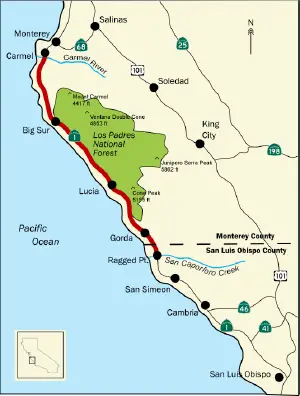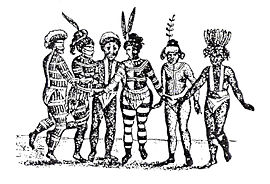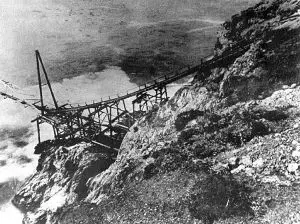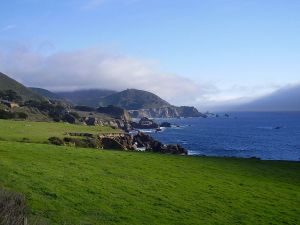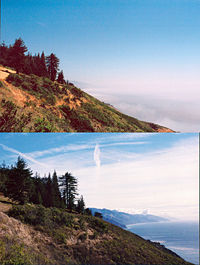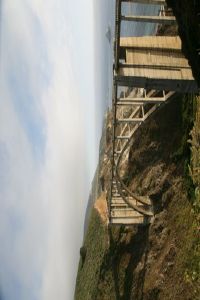Difference between revisions of "Big Sur" - New World Encyclopedia
Mary Anglin (talk | contribs) m (→Big Sur today) |
Mary Anglin (talk | contribs) |
||
| Line 56: | Line 56: | ||
Big Sur remains sparsely populated, with about 1,000 inhabitants, according to the 2000 U.S. Census. The people of Big Sur today are a diverse mix: descendants of the original settler and rancher families, artists and other creative types, along with wealthy home-owners from the worlds of entertainment and commerce. There are no urban areas, although three small clusters of gas stations, restaurants, and motels are often marked on maps as "towns": Big Sur, in the Big Sur River valley, Lucia, near Limekiln State park, and Gorda, on the southern coast. The [[economy]] is almost completely based on [[tourism]]. Much of the land along the coast is privately owned or has been donated to the state park system, while the vast [[Los Padres National Forest]] and [[Fort Hunter Liggett|Fort Hunter Liggett Military Reservation]] encompass most of the inland areas. The mountainous terrain, environmentally conscious residents, and lack of property available for development have kept Big Sur almost unspoiled, and it retains an isolated, [[frontier]] mystique. | Big Sur remains sparsely populated, with about 1,000 inhabitants, according to the 2000 U.S. Census. The people of Big Sur today are a diverse mix: descendants of the original settler and rancher families, artists and other creative types, along with wealthy home-owners from the worlds of entertainment and commerce. There are no urban areas, although three small clusters of gas stations, restaurants, and motels are often marked on maps as "towns": Big Sur, in the Big Sur River valley, Lucia, near Limekiln State park, and Gorda, on the southern coast. The [[economy]] is almost completely based on [[tourism]]. Much of the land along the coast is privately owned or has been donated to the state park system, while the vast [[Los Padres National Forest]] and [[Fort Hunter Liggett|Fort Hunter Liggett Military Reservation]] encompass most of the inland areas. The mountainous terrain, environmentally conscious residents, and lack of property available for development have kept Big Sur almost unspoiled, and it retains an isolated, [[frontier]] mystique. | ||
| − | {{wide image|Partington Ridge panorama.jpg| | + | {{wide image|Partington Ridge panorama.jpg|700px||A [[panoramic photograph]] taken from Partington Ridge near Big Sur approximately <span style="white-space:nowrap">1,000 feet (300 m)</span> above [[California State Route 1|Highway 1]].}} |
==Climate== | ==Climate== | ||
Revision as of 07:08, 8 May 2008
Big Sur is a sparsely populated region of the central California, United States coast where the Santa Lucia Mountains rise abruptly from the Pacific Ocean. The terrain offers stunning views, making Big Sur a popular tourist destination. Big Sur's Cone Peak is the highest coastal mountain in the lower 48 states, ascending nearly a mile (5,155 feet/1.6 km) above sea level, only three miles (4.8 km) from the ocean.[1]
Although Big Sur has no specific boundaries, many definitions of the area include the 90 miles (145 km) of coastline between the Carmel River and San Carpoforo Creek, and extend about 20 miles (32 km) inland to the eastern foothills of the Santa Lucias. Other sources limit the eastern border to the coastal flanks of these mountains, only three to 12 miles (4.8-19 km) inland.
The northern end of Big Sur is about 120 miles (193 km) south of San Francisco, and the southern end is approximately 245 miles (394 km) north of Los Angeles.
History
Aboriginal Americans
Three tribes of Native Americans—the Ohlone, Esselen, and Salinan—were the first inhabitants of the area now known as Big Sur. Archaeological evidence shows that they lived in the area for thousands of years, leading a nomadic, hunter-gatherer existence.[2]
Few traces of their material culture have survived. Their arrow heads were made of obsidian and flint, which indicates trading links with tribes hundreds of miles away, since the nearest sources of these rocks are in the Sierra Nevada mountains and the northern California Coast Ranges.
These early tribes followed local food sources seasonally, living near the coast in winter to harvest rich stocks of mussels, abalone and other sea life, and moving inland at other times to harvest oak acorns. Bedrock mortars - large exposed rocks hollowed out into bowl shapes to grind the acorns into flour - can be found throughout Big Sur. The tribes also used controlled burning techniques to increase tree growth and food production. [3]
Spanish exploration and settlement
The first Europeans to see Big Sur were Spanish mariners led by Juan Cabrillo in 1542, who sailed up the coast without landing. Two centuries passed before Spain attempted to colonize the area. In 1769, an expedition led by Gaspar de Portolà was the first Europeans known to set foot in Big Sur, in the far south near San Carpoforo Canyon. [4] Daunted by the sheer cliffs, his party avoided the area and pressed far inland.
Portolà landed in Monterey Bay in 1770, and with Father Junìpero Serra, who helped found the majority of the missions in California, established the town of Monterey, which became the capital of the Spanish colony Alta California. The Spanish gave Big Sur its name during this period, calling the region el país grande del sur (the Big Country of the South) which was often shortened to el sur grande, because it was a vast, unexplored, and impenetrable land south of their capital at Monterey.
The Spanish colonization devastated the Native population, which perished from European diseases or forced labor and malnutrition at the missions in the eighteenth century, while many remaining members assimilated with Spanish and Mexican ranchers in the nineteenth century. [5]
Ranchos and homesteads
Along with the rest of California, Big Sur became part of Mexico when it gained independence from Spain in 1821. In 1834, the Mexican governor José Figueroa granted a 9,000 acre (36 km²) rancho in northern Big Sur to Juan Bautista Alvarado. His uncle by marriage, Captain J.B.R Cooper, assumed ownership soon afterwards. The oldest surviving structure in Big Sur, the so-called Cooper Cabin, was built in 1861 on the Cooper ranch [6].
In 1848, as a result of the Mexican-American War, Mexico ceded California to the United States. After passage of the federal Homestead Act in 1862, a few hardy pioneers moved into Big Sur, drawn by the promise of free 160 acre (0.6 km²) parcels. Many local sites are named after the settlers from this period: Gamboa, Pfeiffer, Post, Partington, Ross and McWay are common place names. Consistent with the Anglo-Hispanic heritage of the area, the new settlers mixed English and Spanish and began to call their new home "Big Sur."
Industrial era and gold rush
From the 1860s through the turn of the twentieth century, lumbering cut down most of the coast redwoods. Along with industries based on tanoak bark harvesting, gold mining, and limestone processing, the local economy provided jobs and supported a large population. In the 1880s, a gold rush boom town, Manchester, sprang up at Alder Creek in the far south. The town boasted a population of 200, four stores, a restaurant, five saloons, a dance hall, and a hotel, but was abandoned soon after the turn of the century. The remains of the abandoned town burned to the ground in 1909. [7]
There were no reliable roads to supply the emerging industries, so local entrepreneurs built small boat landings at a few coves along the coast, such as Bixby Landing. [8] None of these landings remain today, and few other signs of this brief industrial period are visible to the casual traveler. The rugged, isolated terrain kept out all but the sturdiest and most self-sufficient settlers. A 30 mile (50 km) trip to Monterey could take three days by wagon, over a rough and dangerous track. [9]
Before and after Highway 1
After the industrial boom faded, the early decades of the twentieth century passed with little change, and Big Sur remained a nearly inaccessible wilderness. As late as the 1920s, only two homes in the entire region had electricity, generated locally by water wheels and windmills. [10] Most of the population lived without power until connections to the California electric grid were established in the early 1950s. Big Sur changed rapidly when Highway 1 was completed in 1937 after eighteen years of construction, aided by New Deal funds and the use of convict labor.
Highway 1 dramatically altered the local economy and brought the outside world much closer, with ranches and farms quickly giving way to tourist venues and second homes. Even with these modernizations, Big Sur was spared the worst excesses of development, due largely to residents who fought to preserve the land. The Monterey County government won a landmark court case in 1962, affirming its right to ban billboards and other visual distractions on Highway 1. [11] The county then adopted one of the country's most stringent land use plans, prohibiting any new construction within sight of the highway.
Big Sur artists and popular culture
In the early to mid-twentieth century, Big Sur's relative isolation and natural beauty began to attract a different kind of pioneer — writers and artists, including Robinson Jeffers, Henry Miller, Edward Weston, Richard Brautigan, Hunter S. Thompson, and Jack Kerouac. Jeffers was among the first of these. Beginning in the 1920s, his poetry introduced the romantic idea of Big Sur's wild, untamed spaces to a national audience, which encouraged many of the later visitors. Henry Miller lived in Big Sur from 1944 to 1962. His 1957 novel Big Sur and the Oranges of Hieronymus Bosch described the joys and hardships that came from escaping the "air conditioned nightmare" of modern life. The Henry Miller Memorial Library, a cultural center devoted to Miller's life and work, is a popular attraction for many tourists. Hunter S. Thompson worked as a security guard and caretaker at Big Sur Hot Springs for eight months in 1961, just before it became the Esalen Institute. While there, he published his first magazine feature in the nationally distributed Rogue Magazine, about Big Sur's artisan and bohemian culture. Jack Kerouac spent a summer in Big Sur in the early 1960's, and wrote a novel titled Big Sur based on his experience there.
The area's increasing popularity and cinematic beauty soon brought the attention of Hollywood. Orson Welles and his wife, Rita Hayworth, bought a Big Sur cabin on impulse during a trip down the coast in 1944. They never spent a single night there, and the property is now the location of a popular restaurant. Elizabeth Taylor and Richard Burton starred in the 1965 film The Sandpiper, featuring many location shots of Big Sur, and a dance party scene on a soundstage built to resemble the same restaurant. The Sandpiper was one of the very few major studio motion pictures ever filmed in Big Sur, and perhaps the only one to use actual Big Sur locales as part of the plot. The DVD, released in 2006, includes a Burton-narrated short film about Big Sur, quoting Robinson Jeffers poetry. Another film based in Big Sur was the 1974 Zandy's Bride, starring Gene Hackman and Liv Ullman. [12]. An adaptation of The Stranger in Big Sur by Lillian Bos Ross, the film portrayed the 1870s life of the Ross family and their Big Sur neighbors.
Big Sur also became home to centers of study and contemplation - a Catholic monastery, the New Camaldoli Hermitage in 1958, the Esalen Institute, a workshop and retreat center in 1962, and the Tassajara Zen Mountain Center, a Buddhist monastery, in 1966. Esalen hosted many figures of the nascent "New Age", and in the 1960s, played an important role in popularizing Eastern philosophies, the "human potential movement," and Gestalt therapy in the United States.
Big Sur today
Big Sur remains sparsely populated, with about 1,000 inhabitants, according to the 2000 U.S. Census. The people of Big Sur today are a diverse mix: descendants of the original settler and rancher families, artists and other creative types, along with wealthy home-owners from the worlds of entertainment and commerce. There are no urban areas, although three small clusters of gas stations, restaurants, and motels are often marked on maps as "towns": Big Sur, in the Big Sur River valley, Lucia, near Limekiln State park, and Gorda, on the southern coast. The economy is almost completely based on tourism. Much of the land along the coast is privately owned or has been donated to the state park system, while the vast Los Padres National Forest and Fort Hunter Liggett Military Reservation encompass most of the inland areas. The mountainous terrain, environmentally conscious residents, and lack of property available for development have kept Big Sur almost unspoiled, and it retains an isolated, frontier mystique.
Climate
It is impossible to generalize about the weather in Big Sur, because the jagged topography causes many separate microclimates. This is one of the few places on Earth where redwoods grow within sight of cacti. Still, Big Sur typically enjoys a mild climate year-round, with a sunny, dry summer and fall, and a cool, wet winter. Coastal temperatures vary little during the year, ranging from the 50s at night to the 70s by day (Fahrenheit) from June through October, and in the 40s to 60s from November through May. Farther inland, away from the ocean's moderating influence, temperatures are much more variable.
The official National Weather Service cooperative station at Pfeiffer Big Sur State Park reports that January is the coolest month with an average maximum of 60.0°F and an average minimum of 43.2°F. August is usually the warmest month, with an average maximum of 77.3°F and an average minimum of 50.2°F. The record maximum temperature was 101°F on August 15, 1994. The record minimum was 27°F, recorded on December 21, 1998, and January 13, 2007. There are an average of 8.8 days annually with highs of 90°F (32°C) or higher and an average of 1.4 days with lows of 32°F (0°C) or lower. Average annual precipitation at the state park headquarters is 41.94 inches, with measurable precipitation falling on an average of 62 days each year. The wettest year was 1983 with 88.85 inches and the driest year was 1990 with 17.90 inches. The wettest month on record was January 1995 with 26.47 inches and the most precipitation in 24 hours was 9.23 inches on January 31, 1963. More than 70% of the rain falls from December through March, while the summer brings drought conditions. Measurable snowfall has not been recorded in coastal Big Sur, but is common in the winter months on the higher ridges of the Santa Lucia Mountains.[13] The abundant winter rains cause rock and mudslides that can cut off portions of Highway 1 for days or weeks, but the road is usually quickly repaired.
Along with much of the central and northern California coast, Big Sur often has dense fog in summer. The summer fog and summer drought have the same underlying cause: a massive, stable seasonal high pressure system that forms over the north Pacific Ocean. The high pressure cell inhibits rainfall and generates northwesterly airflows. These prevailing summer winds from the northwest push the warm ocean surface water to the southeast, away from the coast, and frigid deep ocean water rises in its place. The water vapor in the air contacting this cold water condenses into fog. [14] The fog usually moves out to sea during the day and closes in at night, but sometimes heavy fog blankets the coast all day. Fog is an essential summer water source for many Big Sur coastal plants. Most plants cannot take water directly out of the air, but the condensation on leaf surfaces slowly precipitates into the ground like rain.
Flora
The many climates of Big Sur result in an astonishing biodiversity, including many rare and endangered species such as the wild orchid Piperia yadonii. Arid, dusty chaparral-covered hills exist within easy walking distance of lush riparian woodland. The mountains trap most of the moisture out of the clouds; fog in summer, rain and snow in winter. This creates a favorable environment for coniferous forests, including the southernmost habitat of the coast redwood (Sequoia sempervirens), which grows only on lower coastal slopes that are routinely fogged in at night. The redwoods are aggressive regenerators, and have grown back extensively since logging ceased in the early twentieth century. The rare Santa Lucia fir (Abies bracteata), as its name suggests, is found only in the Santa Lucia mountains. A common "foreign" species is the Monterey pine (Pinus radiata), which was uncommon in Big Sur until the late 19th century, when many homeowners began to plant it as a windbreak. There are many broad leaved trees as well, such as the tanoak (Lithocarpus densiflorus), coast live oak (Quercus agrifolia), and California Bay Laurel (Umbellularia californica). In the rain shadow, the forests disappear and the vegetation becomes open oak woodland, then transitions into the more familiar fire-tolerant California chaparral scrub.
Demographic estimate
The United States does not define a census-designated place called Big Sur, but it does define a Zip Code Tabulation Area (ZCTA), 93920. Because Big Sur is contained roughly within this Zip Code Tabulation Area, it is possible to obtain Census data from the United States 2000 Census for the area even though data for "Big Sur" is unavailable.
According to the US 2000 census, there were 996 people, 884 households, and 666 housing units in the 93920 ZCTA. The racial makeup of this area was 87.6% White, 1.1% African American, 1.3% Native American, 2.4% Asian, 0.0% Pacific Islander, 5.5% from other races, and 3.0% from two or more races. Hispanic or Latino of any race were 9.6% of the population.
In the 93920 ZCTA, the population age is widely distributed, with 20.2% under the age of 19, 4.5% from 20 to 24, 26.9% from 25 to 44, 37.0% from 45 to 64, and 11.2% who were 65 years of age or older. The median age is 43.2 years.
The median income for a household in 93920 ZCTA is $41,304, and the median income for a family is $65,083.
Tourism
Although some Big Sur residents catered to adventurous travelers in the early twentieth century,[15] the modern tourist economy began when Highway 1 opened the region to automobiles, and only took off after World War II-era gasoline rationing ended in the mid-1940s. Most of the 3 million tourists who visit Big Sur each year never leave Highway 1, because the adjacent Santa Lucia mountain range is one of the largest roadless areas near a coast in the lower 48 states. The highway winds along the western flank of the mountains mostly within sight of the Pacific Ocean, varying from near sea level up to a thousand-foot sheer drop to the water. Because gazing at the views while driving is inadvisable, the highway features many strategically placed vista points allowing motorists to stop and admire the landscape. The section of Highway 1 running through Big Sur is widely considered as one of the most scenic driving routes in the United States, if not the world.
The land use restrictions that preserve Big Sur's natural beauty also mean that tourist accommodations are limited, often expensive, and fill up quickly during the busy summer season. There are fewer than 300 hotel rooms on the entire 90 mile (140 km) stretch of Highway 1 between San Simeon and Carmel, only three gas stations, and no chain hotels, supermarkets, or fast-food outlets[16]. The lodging options are rustic cabins, motels, and campgrounds, or costly, exclusive five-star resorts, with little in between. Most lodging and restaurants are clustered in the Big Sur River valley, where Highway 1 leaves the coast for a few miles and winds into a redwood forest, protected from the chill ocean breezes and summer fog.
Besides sightseeing from the highway, Big Sur offers hiking, mountain climbing, and other outdoor activities. There are a few small, scenic beaches that are popular for walking, but usually unsuitable for swimming because of unpredictable currents and frigid temperatures. Big Sur's nine state parks have many points of interest, including one of the few waterfalls on the Pacific Coast that plunges directly into the ocean, the ruins of a grand stone cliffside house that was the region's first electrified dwelling, and the only complete nineteenth century lighthouse complex open to the public in California, set on a lonely, windswept hill that looks like an island in the fog.
List of state parks (north to south)
- California State Parks Articles
- Carmel River State Beach
- Point Lobos State Reserve
- Garrapata State Park
- Point Sur Lightstation State Historic Park
- Andrew Molera State Park
- Pfeiffer Big Sur State Park
- Julia Pfeiffer Burns State Park
- John Little State Reserve
- Limekiln State Park
- List of state parks (Wikipedia articles)
- Carmel River State Park
- Point Lobos State Reserve
- Garrapata State Park
- Point Sur Lightstation State Historic Park
- Andrew Molera State Park
- Pfeiffer Big Sur State Park
- Julia Pfeiffer Burns State Park
- John Little State Reserve
- Limekiln State Park
- Federal Parks
- Ventana Wilderness
Images of Big Sur
- Big sur sunset.jpg
Sunset over Big Sur on the north-western edge of Andrew Molera State Park.
Notes
- ↑ Henson, Paul and Usner, Donald. The Natural History of Big Sur 1993, University of California Press; Berkeley, California; page 11
- ↑ Analise Elliott. 2005. Hiking & Backpacking Big Sur. Wilderness Press; Berkeley, California. page 21
- ↑ Henson and Usner, pages 269-270
- ↑ Ibid., page 272
- ↑ Ibid., pages 264-267
- ↑ Kathleen E. Davis. Big Sur Cabin California Department of Parks & Recreation. Retrieved May 8, 2008.
- ↑ John Woolfenden. 1981. Big Sur: A Battle for the Wilderness 1869-1981. The Boxwood Press; Pacific Grove, California. page 72
- ↑ Rosalind Sharpe Wall. 1989. A Wild Coast and Lonely: Big Sur Pioneers. Wide World Publishing; San Carlos, California; pages 126-130
- ↑ Eliott, page 24
- ↑ Henson and Usner, page 328; Woolfenden, page 64
- ↑ National Advertising Co. v. County of Monterey, 211 Cal.App.2d 375, 1962
- ↑ Monterey County Film Commission. Films Shot in Monterey County Retrieved May 8, 2008.
- ↑ Western Regional Climate Center website
- ↑ Henson and Usner, pages 33-35
- ↑ Woolfenden, page 10
- ↑ Lodging Guide to Big Sur, Big Sur Chamber of Commerce website
ReferencesISBN links support NWE through referral fees
- Big Sur, Jack Kerouac, Penguin Books, Reprint edition (1962, reprinted 1992), 256 pages, ISBN 0-14-016812-5
- Big Sur: A Battle for the Wilderness 1869-1981, John Woolfenden, The Boxwood Press (1981), 143 pages, ISBN 0-910286-87-6
- Big Sur: Images of America, Jeff Norman, Big Sur Historical Society, Arcadia Publishing (2004), 128 pages, ISBN 0-7385-2913-3
- Big Sur and the Oranges of Hieronymus Bosch, Henry Miller, New Directions Publishing Corp (1957), 404 pages, ISBN 0-8112-0107-4
- Hiking & Backpacking Big Sur, Analise Elliott, Wilderness Press (2005), 322 pages, ISBN 0-89997-326-4
- The Natural History of Big Sur, Paul Henson and Donald J. Usner, University of California Press (1993), 416 pages, ISBN 0-520-20510-3
- A Wild Coast and Lonely: Big Sur Pioneers, Rosalind Sharpe Wall, Wide World Publishing, (1989, reprinted April 1992), 264 pages, ISBN 0-933174-83-7
External links
- Great pictures of Big Sur From SummitPost.org
- A Short History of Big Sur From the Big Sur Chamber of Commerce
- A Guide to California's Big Sur: A comprehensive visitor's guide to the Big Sur region
- "The Big Sur cabin": Dating the earliest cabin in Big Sur, 1861
- Henry Miller Memorial Library in Big Sur
- Ventana Wilderness Alliance: Wilderness conservation and hiking trails info in the Big Sur area
- Google Map of Big Sur
- Microsoft Live Map of Big Sur
- Hiking In Big Sur Hiking In Big Sur
- Esselen Tribe Website Esselen Tribe of Monterey County
- Big Sur on the Central Coast Big Sur on the Central Coast
- Monterey County Film Commission Monterey County Film Commission
Credits
New World Encyclopedia writers and editors rewrote and completed the Wikipedia article in accordance with New World Encyclopedia standards. This article abides by terms of the Creative Commons CC-by-sa 3.0 License (CC-by-sa), which may be used and disseminated with proper attribution. Credit is due under the terms of this license that can reference both the New World Encyclopedia contributors and the selfless volunteer contributors of the Wikimedia Foundation. To cite this article click here for a list of acceptable citing formats.The history of earlier contributions by wikipedians is accessible to researchers here:
The history of this article since it was imported to New World Encyclopedia:
Note: Some restrictions may apply to use of individual images which are separately licensed.
